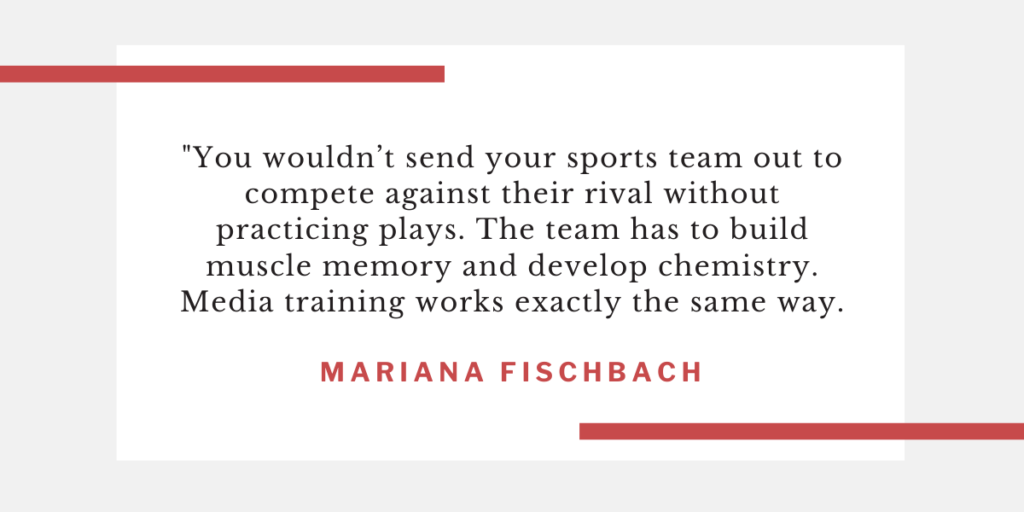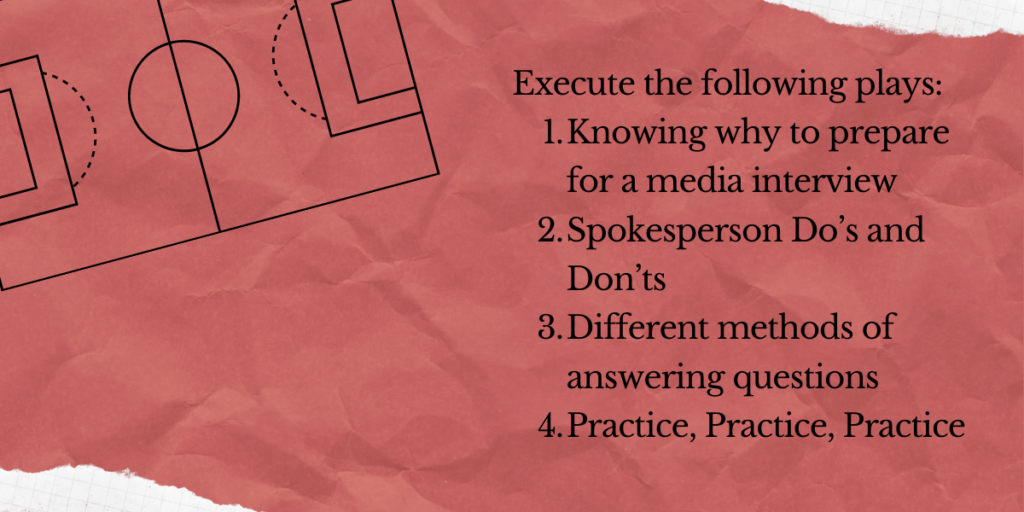Every organization needs to make big decisions about their media relations approach. You must determine who within your organization will own the program and identify the conversations you want to lead. Once you’ve done this, you need to ensure your spokespeople are media trained and ready to take an interview on short notice.
Building muscle memory through media training
You wouldn’t send your sports team out to compete against their rival without practicing plays. The team has to build muscle memory and develop chemistry. Media training works exactly the same way. It builds your spokesperson’s muscle memory and familiarizes them with the process. With practice and coaching, they will know a series of plays to implement based on the type of interview.

Types of interviews:
Your spokesperson may need to take an interview in the following formats:
- Written responses via email that quote them directly in print or digital articles;
- A phone interview or on-camera conference call that will quote the spokesperson throughout digital and print articles;
- A podcast recording that will feature a Q&A style interview that turns into the basis for an article or is printed as submitted;
- Broadcast interview in which the journalist will utilize an (on average) 30-second video segment of the spokesperson’s interview – sometimes these segments are live.
It’s important to note that each medium brings nuances in the way your spokesperson needs to deliver their message to be effective. Therefore, as you begin your organization’s media training journey it’s important to emphasize the differences in interview formats. The spokesperson’s technique will have to change with each.
For example, broadcast requires an additional set of skills as the spokesperson has to convey key messages via body language in addition to speaking. For broadcast, we usually like to bring in additional partners that solely focus on this medium in order to really help the spokesperson prepare for all of the nuances that broadcast demands.
Every time I advise clients on preparing for a broadcast interview, I kindly ask them to stay away from sounding and looking like Ricky Bobby on this now iconic scene from the film Talladega Nights: The Ballad of Ricky Bobby. Take a look, and you’ll see why!
Developing a media training process for each type of interview – whether creating an internal training process or bringing in an outside professional – is key.

Media training – how to get started
As you build a media training program or work with an agency such as ours to get your spokespeople trained, we recommend the following “plays” to build out your media training playbook:
Play #1 – Knowing why to prepare for a media interview
In coordinating with spokespeople for media interviews, it’s important to discuss the importance of training. They need to know why training matters and how it will help them in the long run. Getting your spokespeople bought in early on in the process is critical to ensuring future interview success.
Play #2 – Spokesperson Do’s and Don’ts
A critical part of media training involves walking spokespeople through things they should and should not do during the interview. For example, letting your spokesperson know which customers they can or cannot name publicly, as well as which facts and figures they can reference versus ones they cannot speak to, is key.
Everything a spokesperson tells the journalist is deemed “on the record”. If something they say isn’t fit for print, the spokesperson must explicitly get the journalist to agree that the information is strictly “off the record” before sharing. This can be very helpful to help them understand context without revealing private info publicly.
Play #3 – Different methods of answering questions
It’s important to identify different ways and tactics spokespeople can use to respond to questions. For example, at times, a journalist’s question may be long winded and a spokesperson’s natural tendency may be to go off on a tangent.
Identify these characteristics and walk the spokesperson through various ways of answering a question. The goal is to deliver quotable soundbites that stand out within the journalist’s report.
You should also practice scenarios in which the spokesperson must politely decline to answer a question if they do not have an answer for it or cannot publicly speak to it.
Play #4 – Practice, Practice, Practice
Once you’ve run through the initial plays, it’s time to put all of that muscle memory into gear and walk through several mock interviews. The spokesperson should be walked through interview exercises designed specifically for the kind of stories and reporters they’ll speak to.
As you do so, identify each reporter’s interview and reporting style and discuss what they respond to and how the spokesperson can adjust their messaging to be more effective for each journalist.
Practice makes perfect! As you start media training your spokesperson, ensure you are going over the above plays and getting them prepared to perform “on the field.”
If you need additional help, Ketner Group is available to help your spokespeople hit the ground running and achieve success! Contact us today to get started on your media training journey.

